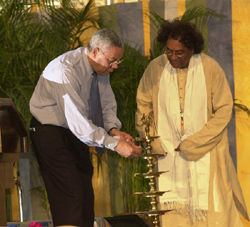Remarks at the Opening of the Silk Road Festival
Secretary Colin L. Powell
SECRETARY POWELL: Thank you very much, ladies and gentlemen. Thank you so very much, Richard, for that kind introduction, and my congratulations to The Smithsonian for putting on this 36th Annual Folklife Festival. With each year's Folklife Festival, the Mall becomes a living cultural exhibition, not only for the citizens of this city, but for the citizens of the world who come to Washington, D.C. In the words of former Smithsonian Secretary S. Dillon Ripley, "The Festival brings the museum out of its glass case and into real life."
I want to thank you also, Yo Yo Ma and your Silk Road Project, to the Aga Khan for his Trust for Culture, to Lawrence Small of the Smithsonian, for all the wonderful work they have done to make this such an exciting and important event. And I am very proud that the State Department had such a role to play in it, and some of my leaders from the Department who had a role to play are here. Under Secretary of State Charlotte Beers and Assistant Secretary of State Beth Jones, and I think Assistant Secretary of State Pat Harrison are here, and they also are deserving of your recognition. (Applause.)
In fact, we did have some diplomatic challenges in making this happen. The two yurts that are here, tents that you will see in due course, they had to be custom made to conform to American laws for access to the handicapped. And so our embassy in Kazakhstan worked closely with the Kazakh Government to make sure they were up to standard -- (laughter) -- and then helped ship them here in time for this Festival. So we are not only culturally pure, we are OSHA-pure as well. I want you to know that. (Laughter and Applause.)
We have seen so many talented people this morning, and we have had such wonderful speakers. And I, as always, enjoyed Yo Yo Ma. But Yo Yo, I have to say the throat singers might have had a slight edge on you. (Laughter.) It was marvelous, and I haven't heard throat singing like that since my last congressional appearance. (Laughter and Applause.) And it was before the Senate, not the House. (Laughter.)
But what these artists have done for you this morning so far is they have painted a marvelous picture of the old Silk Road and the central place that the Silk Road played in our own history, our own culture, and in our own civilization.
Listening to this morning's speakers, you can almost see Marco Polo trekking eastward toward lands unknown to Europeans, or hear the sounds of a merchant caravan heading west with its cargo of silks and spices.
The Silk Road of old was the main link between the civilizations of the east, Central Asia, and Europe. From Europe, the products and ideas of Central and East Asia then spread to the New World of the Americas. All of our peoples were enriched by the exchange of goods, the exchange of ideas, and the exchange of cultures.
But the Silk Road is more than a subject for magazines and museums. It is more than an image of past glories. The nations of Central Asia are once again joining the nations at either end of the Silk Road on a path to a better future for all. There is far to go, and the region's security, stability, and prosperity depend on critical economic and political reforms. But the Silk Road is once again a living reality, as the over 350 artists and craftspeople from 20 nations here testify.
Now, in our new age of globalization, we are restoring the linkages and the interchanges that once made the Silk Road so rich and so vital. We have been making up for lost time. Our political, economic, diplomatic, and security contacts have increased with all the nations along the central part of the Silk Road, boosted by our cooperation especially as we came together in the campaign against terrorism following 9/11 last year.
But even more important, our cultural and institutional ties have also grown. We are once again exchanging ideas and learning about cultures with all of the countries and peoples along the Silk Road.
The links between our peoples are the most vital and enduring elements of our ties. Festivals like the Smithsonian Silk Road Festival play a major role in helping us get reacquainted and start learning from each other once again. As the theme of this exhibition reminds us, it's all about "Connecting cultures and creating trust."
This Festival, like the future, stretches ahead before us. So without further delay, and with sincere thanks for your patience, let me now light the lamp that will allow us to embark on our journey along the Silk Road. Thank you very, very much.
(Applause.)
[End]